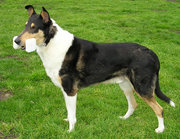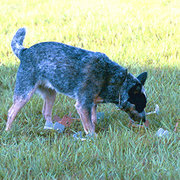 This
Smooth Collie retrieves an obedience dumbbell made of wood; others are made
of metal.
This
Smooth Collie retrieves an obedience dumbbell made of wood; others are made
of metal.
|
From Wikipedia the free encyclopedia, by MultiMedia |
Obedience training involves training an animal, most often a Dog, to obey basic control commands such as sit, down, and heel.
There are almost as many methods of training as there are trainers, but over time the basic strategy has shifted away from punishment or avoidance training (negative reinforcement) to positive reinforcement, where the Dog is rewarded for doing the correct thing during most phases of training rather than being punished for not doing what the trainer wants.
Working Dogs have always learned to obey commands related to the work that they historically performed, such as when a sheepDog moves a flock of animals in response to a shepherd's whistled directions, or a hunting Dog searching for (or chasing down) quarry or leaving the treed quarry at the hunter's command.
It has been only in more modern times, as the Dog has become more of a companion than a hired servant (paid in food and a dry place to lie down) who lived in the barn with other livestock, that obedience training has become a separate and specific skill (for both the owner and the Dog).
In the twentieth century, formalized Dog training originated in military and police applications, and many theories on how to train a Dog came out of the same mentality that created boot camp for soldiers.
In the middle and late part of the century, however, more research into operant conditioning and positive reinforcement occurred as wild animal shows became more popular-- Traditional methods of teaching animals behavior (as with Dogs) proved irrelevant when, for example, a trainer had to instruct a dolphin or an orca. These aquatic mammal trainers used clickers (a small box that makes a loud click when pushed on) to "mark" desired behavior, giving food as a reward. The improvements in training methods spread gradually into the world of Dog training. Every decade sees new methods and new attitudes reach mainstream training classes.
There are at least three levels of obedience training:
At a basic level, owners want Dogs with whom they can pleasantly share a house, a car, or a walk in the park. Some Dogs need only a minimum amount of training to learn to eliminate outside (be housebroken), to sit, to lie down, or to come on command (obey a recall). Many other Dogs prove more challenging.
New Dog owners might find training difficult because they expect Dogs to think and act like humans, and are surprised and baffled when the Dogs don't (or they fail to make progress because they fail to realize that the Dogs don't).
Dogs who demonstrate the previously mentioned basic skills, as well as walking reasonably well on a leash and a few other minor tasks, can be tested for and earn the American Kennel Club's (AKC) Canine Good Citizen title.
The following commands are commonly taught in basic obedience classes:
The specific command word is not important, although the preceding list covers some of the more common words. Short, clear words that are easily understood by other humans are generally recommended; that way, people will understand what a handler is telling his Dog to do and other handlers have a good chance of controlling someone else's Dog if necessary. In fact, Dogs can learn commands in any language or other communications medium, including whistles, mouth sounds, hand gestures, and so forth.
While Dogs can be trained far beyond these rudiments, a Dog that obeys these commands will be a pleasure to keep and take out. Off-leash obedience is the hallmark of a well-trained Dog.
Leash training is another facet of training a Dog which teaches them to walk on a leash without pulling or jerking. There are many methods for doing this, such as simply turning and walking the other way when the Dog moves in front of the handler, or firmly grasping the leash at the collar and guiding the Dog into position beside the handler.
Today, many trainers advocate using a plain collar and leash for leash training rather than specialized training collars, such as slip collars and prong collars. Both of these can potentially inflict damage to a Dog's neck and should not be used except in specific cases when recommended by, and supervised by, a knowledgeable trainer. Historically, slip collars have been used as a matter of course, and some trainers still recommend them for basic training on any Dog; such collars should be used in a way that makes a quick popping or zipping sound to startle the Dog and are then quickly released, not to choke the Dog or to put tight pressure on the Dog's neck. Advocates of plain-collar training encourage students to ask their instructors to allow them to use plain collars, not slip collars; the techniques for training, however, are slightly different and some instructors might not agree.
However, hard pulling even on a plain collar can damage a Dog's neck, so during times when it is not possible to work on training and the Dog still pulls on the leash, owners can use a nose halter instead of a collar; these are sold under brand names such as Gentle Leader and Halti. Even these must be used carefully, not for harshly jerking a Dog, as they can jerk a Dog's head suddenly to the side.
There are a few commands that many domestic Dogs learn, but that are not part of the basic repetoire.
For Dog owners who enjoy competition and relish the opportunity to work as a highly tuned team with their Dogs, competitive obedience is available.
In competition, merely sitting, lying down, or walking on a leash are insufficient. The Dog and handler must perform the activities off leash and in a highly stylized and carefully defined manner. For example, on a recall, the Dog must come directly to the handler, without sniffing or veering to one side, and sit straight in front of the handler, not at an angle or off to one side or the other.
 This
Smooth Collie retrieves an obedience dumbbell made of wood; others are made
of metal.
This
Smooth Collie retrieves an obedience dumbbell made of wood; others are made
of metal.
A handler can choose her own commands, but the actions that the Dog must perform are well defined. As a Dog progresses from novice to advanced competition, the requirements become more challenging and the list of actions that he must perform becomes longer. Exercises in AKC competition are offered at three levels: Novice, Open (intermediate), and Utility (advanced); a Dog must complete the requirements at each level before moving on the next. AKC exercises are:
 An ACD finding a scent article as part of obedience competition.
An ACD finding a scent article as part of obedience competition.For example, in the scent article exercise, the Dog searches for a dumbbell that has been scented by the handler and placed within a pile of identical metal and leather dumbbells by an assistant. The Dog must find the correct article based only on its unique scent and retrieve it.
Dogs can earn obedience titles including an obedience championship. For example, the American Kennel Club (AKC) awards an "Obedience Trial Championship" (OTCh) to the Dog-and-handler team that defeats a large number of other teams in open competition. In the United States, a purebred Dog recognized by the AKC can compete under AKC rules; Dogs not recognized by the AKC can earn titles in the United Kennel Club (UKC), Mixed Breed Dog Club of America (MBDCA), American Mixed Breed Obedience Registry (AMBOR), or Australian Shepherd Club of America (ASCA).
Contrary to what one might expect, an obedience champion might not have excellent companion obedience skills; the actions are so highly formalized for performance in the obedience ring that they do not automatically translate to a Dog who walks pleasantly on a leash, comes when called in the back yard, or keeps his nose off the dinner table.
There are many reasons for training Dogs beyond the level required for basic companionship. For example, service Dogs must obey their sit and down commands perfectly at all times, but they do not have to conform to the rigid rules of competitive obedience.
Dogs competing in Dog sports, such as flyball, agility or Schutzhund, must be trusted in an open field, off leash and surrounded by other people, Dogs, hamburgers, and frisbees. This requires more focused attention on the owner and a better recall than that found in most household companion Dogs, but again it can be a different kind of training than that required for formal obedience.
Certain breeds, such as Border Collies and Golden Retrievers, are easier to train than others, such as some hounds and sled Dogs. Still, the Border Collie's high energy level can lead it to unwanted behavior if its exercise and mental needs are not met, whereas the Golden Retriever can be somewhat more relaxed. Dog intelligence is exhibited in many different ways, and a Dog who might not be easy to train might none-the-less be quite adept at figuring out how to open kitchen cabinets or to escape from the yard. Novice Dog owners need to consider a Dog's trainability as well as its energy level, exercise requirements, and other factors before choosing a new pet.
No breed is impossible to obedience train, but novice owners might find that training some breeds is quite difficult. The capacity to learn basic obedience—and even complicated behavior—is inherent in all Dogs. Owners must simply be more patient, or creative, or both, with some breeds than with others.
Organizations offering obedience titles in the United States:
Dogs, made by MultiMedia | Free content and software
This guide is licensed under the GNU Free Documentation License. It uses material from the Wikipedia.